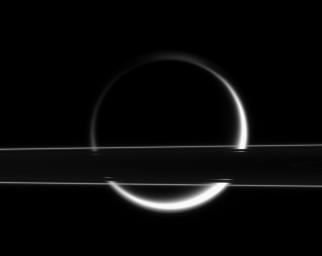
|
Titan Shines Through
- Click the image above for a larger view
- Full-Res JPEG (912 x 725) (16.8 kB)
- Full-Res TIFF (912 x 725) (662.2 kB)
Caption:
Titan's smoggy atmosphere glows brilliantly in scattered sunlight, creating a thin, gleaming crescent beyond Saturn's rings. At this slight angle above the ringplane, the thin F ring shines brightly. Light from Titan's eastern and western limbs (edges) penetrates the Cassini Division, which looks like a thin gap from this angle.
The image was taken in visible light with the Cassini spacecraft narrow-angle camera on Jan. 18, 2006, at a distance of approximately 1 million kilometers (600,000 miles) from Saturn. Planet-sized Titan (5,150 kilometers, or 3,200 miles across) was 2.2 million kilometers (1.4 million miles) from Cassini at that time. The image scale is 13 kilometers (8 miles) per pixel on Titan.
Background Info:
The Cassini-Huygens mission is a cooperative project of NASA, the European Space Agency and the Italian Space Agency. The Jet Propulsion Laboratory, a division of the California Institute of Technology in Pasadena, manages the mission for NASA's Science Mission Directorate, Washington, D.C. The Cassini orbiter and its two onboard cameras were designed, developed and assembled at JPL. The imaging operations center is based at the Space Science Institute in Boulder, Colo.
For more information about the Cassini-Huygens mission visit http://saturn.jpl.nasa.gov/home/index.cfm . The Cassini imaging team homepage is at http://ciclops.org .
Cataloging Keywords:
| Name | Value | Additional Values |
|---|---|---|
| Target | Titan | Cassini Division, F Ring, Saturn, Saturn Rings |
| System | Saturn | |
| Target Type | Satellite | Gap, Planet, Ring |
| Mission | Cassini-Huygens | |
| Instrument Host | Cassini Orbiter | |
| Host Type | Orbiter | |
| Instrument | Imaging Science Subsystem (ISS) | |
| Detector | Narrow Angle Camera | |
| Extra Keywords | Atmosphere, Grayscale, Visual | |
| Acquisition Date | ||
| Release Date | 2006-03-03 | |
| Date in Caption | 2006-01-18 | |
| Image Credit | NASA/JPL/Space Science Institute | |
| Source | photojournal.jpl.nasa.gov/catalog/PIA08126 | |
| Identifier | PIA08126 | |
